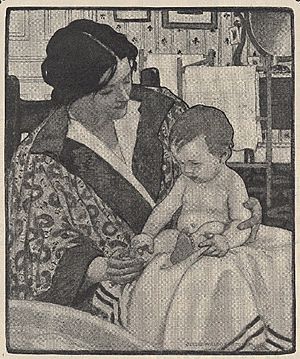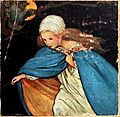Jessie Willcox Smith facts for kids
Quick facts for kids
Jessie Willcox Smith
|
|
|---|---|
 |
|
| Born | September 6, 1863 |
| Died | May 3, 1935 (aged 71) Philadelphia, Pennsylvania
|
| Nationality | American |
| Known for | Illustrations |
| Movement | The Golden Age of Illustration |
| Awards |
|
| Elected | Society of Illustrators' Hall of Fame, 1992 |
| Years active | 1880–1935 |
Jessie Willcox Smith (born September 6, 1863 – died May 3, 1935) was a famous American illustrator. She lived and worked during a time known as the "Golden Age of American Illustration". Many people thought she was one of the best illustrators ever.
Jessie created pictures for many books and magazines in the late 1800s and early 1900s. Her art appeared in popular magazines like Century, Collier's, Harper's, and Ladies' Home Journal. She worked closely with Good Housekeeping magazine for many years. She drew all their covers from December 1917 to 1933. She also created a long series of Mother Goose pictures for them.
Jessie illustrated more than 60 books. Some of these include Little Women and An Old-Fashioned Girl by Louisa May Alcott. She also drew pictures for Evangeline by Henry Wadsworth Longfellow and A Child's Garden of Verses by Robert Louis Stevenson.
Contents
Early life
Jessie Willcox Smith was born in Philadelphia, Pennsylvania, on September 6, 1863. She was the youngest daughter of Charles Henry Smith and Katherine DeWitt Willcox Smith. Jessie went to private schools when she was young.
At age sixteen, she moved to Cincinnati, Ohio, to live with her cousins. She finished her education there. In 1883, she trained to be a teacher and taught kindergarten. However, she found working with young children too hard on her body. A friend or cousin convinced her to try an art class. Jessie quickly discovered she had a natural talent for drawing.
Career
Learning to be an Artist
Around 1884 or 1885, Jessie started attending art schools in Philadelphia. She went to the Philadelphia School of Design for Women and the Pennsylvania Academy of the Fine Arts (PAFA). There, she learned from famous artists like Thomas Eakins. Eakins taught her to use photography to help with her illustrations.
In May 1888, while still a student, her drawing Three Little Maidens All in a Row was printed in St. Nicholas Magazine. At that time, illustration was a good way for women to earn a living. Drawing pictures for children's books or family scenes was seen as a suitable job for women artists.
Jessie graduated from PAFA in June 1888. The same year, she got a job at the Ladies' Home Journal. This was the first magazine made just for women. She helped with advertising art, like finishing sketches and designing borders. She also illustrated a poetry book called New and True in 1892.
In 1894, Jessie took classes with Howard Pyle at Drexel Institute. Pyle was a very important teacher for many artists of her time. He encouraged them to work for major publishers. Jessie said that working with Pyle cleared away "all the cobwebs and confusions" that art students often faced. She studied with him until 1897.
The Red Rose Girls
While studying at Drexel, Jessie met Elizabeth Shippen Green and Violet Oakley. They were also very talented artists and became lifelong friends. They shared a studio in Philadelphia. In 1897, Oakley and Smith illustrated Evangeline by Henry Wadsworth Longfellow. Their teacher, Howard Pyle, helped them get this first big job.
Around 1900, Jessie's career really took off. She illustrated many books and magazines. She also created an advertisement for Ivory soap. Her art appeared in Scribner's, Harper's Bazaar, and St. Nicholas Magazine.
Green, Smith, and Oakley became known as "The Red Rose Girls." This was because they lived and worked together for four years at the Red Rose Inn in Villanova, Pennsylvania. They leased the inn and were joined by their parents and Henrietta Cozens, who managed the inn. These women were seen as the most important artists of American home life at the time. Their beautiful pictures of mothers and children are still loved today.
In 1903, Green and Smith illustrated a calendar called The Child. Jessie also won an award at the Pennsylvania Academy of the Arts that year. In 1904, the artists had to leave the Red Rose Inn. They had a farmhouse remodeled in West Mount Airy, Philadelphia. They called their new home and workplace "Cogslea." This name came from the first letters of their last names and Henrietta Cozens' name.
Becoming a Modern Artist
As more women had chances to get an education in the late 1800s, many became artists. They started their own art groups. At first, art by "lady artists" was not always taken seriously. To change this, women artists became more confident in showing their work. They were part of the "New Woman" movement, which was about educated, modern, and freer women. Artists like Jessie helped show what this new type of woman looked like through their art and their own lives.
Continued Success
In the late 1800s and early 1900s, most people who bought American magazines were women. As more women became artists, publishers hired them to draw pictures that showed the world from a woman's point of view. Jessie Willcox Smith was one of these successful illustrators. She was especially known for her covers and story illustrations. She also drew pictures for advertisements.
Many people say Jessie Smith was the "greatest children's book illustrator." Her work is often compared to Mary Cassatt's because of how sweetly she drew children.
Jessie was a member of The Plastic Club in Philadelphia, started in 1897. This group helped women artists support each other and sell their work. In 1904, Jessie became a member of the Society of Illustrators. In 1905, she was one of seven top artists who agreed to work only for Collier's magazine.
By 1910, Jessie Smith was earning a lot of money from her art. She was as popular as a "media star," like Norman Rockwell. Jessie was famous for her pictures of children and women, which millions of people loved.
In 1911, Jessie's parents and her old teacher, Howard Pyle, passed away. Her friend Elizabeth Shippen Green also got married. Jessie decided to build her own house and studio nearby. She called it Cogshill. She lived there with Henrietta Cozens, her aunt, and her brother.
She continued to draw for magazines, including a series of Mother Goose illustrations for Good Housekeeping. These pictures were so popular that they were made into a book called The Jessie Willcox Smith Mother Goose. This book showed her talent for drawing mothers and children in a realistic way.
Jessie was very good at painting children. She would tell them stories or give them milk and cookies to help them relax and focus. She wrote in a 1917 Good Housekeeping article that "A child will always look directly at anyone who is telling a story; so while I paint I tell tales marvelous to hear." In 1915, she finished one of her most famous works for Charles Kingsley's The Water-Babies.
Jessie drew every cover for Good Housekeeping magazine from December 1917 to April 1933. This made her the artist with the longest run of magazine covers. She created 184 illustrations of family scenes for the magazine. She was one of the highest-paid illustrators of her time. She also made illustrations for Kodak and Procter & Gamble's Ivory soap. She drew pictures for Collier's and for books by Charles Dickens, like Tiny Tim.
Jessie kept creating illustrations throughout her life. After 1925, she started painting more portraits. She used photography as a tool for her portraits, a technique she learned from Thomas Eakins.
Artistic Style
Jessie Smith's art style changed over her life. At first, she used dark lines to outline bright colors. Later, her lines and colors became softer, almost blending together. She used different art materials like oil paints, watercolors, and pastels. She often painted with oils over charcoal drawings on textured paper. Her use of color was inspired by French Impressionist painters.
Most of Jessie's art focused on children and a mother's love. Many people believe she was trying to show the kind of love she wished she had as a child. Jessie preferred to use real children as models, not child actors. She felt real children had more spirit and curiosity. She would invite friends to visit and watch their children play to get ideas for her drawings.
Death and Legacy
Jessie Willcox Smith was not a big traveler. But in 1933, she agreed to tour Europe. During her trip, her health got worse. She passed away in her sleep at her home, Cogshill, in 1935, at age 71. In 1936, an exhibition of her works was held to honor her.
In 1991, Jessie Smith became only the second woman to be put into The Hall of Fame of the Society of Illustrators. Later, her friends Elizabeth Shippen Green and Violet Oakley were also inducted.
Jessie gave 14 of her original artworks to the Library of Congress. These works help show the "Golden Age of Illustration" (1880-1920s). Her personal papers are kept at the Archives of American Art at the Smithsonian Institution.
Collections
Her artworks can be found in these places:
- Brandywine Heritage Galleries, Brandywine River Museum
- Delaware Art Museum
- Rare Book Department, Free Library of Philadelphia
- National Museum of American Illustration
- New York Public Library Digital Gallery.
- Pennsylvania Academy of the Fine Arts
- Philadelphia Museum of Art
- United States Library of Congress
- University of Michigan Museum of Art
Works
From 1888 to 1932, Jessie Smith created illustrations for over 250 magazines, 200 magazine covers, and 60 books. She also made prints, calendars, posters, and painted portraits. Here are some of her works:
Illustrations
- New and True [Poems] – Mary Wiley Staver (1892)
- Evangeline: A Tale of Acadie – Henry Wadsworth Longfellow (1897)
- An Old-Fashioned Girl – Louisa May Alcott (1902)
- Rhymes of Real Children – Betty Sage (1903)
- A Child's Garden of Verses – Robert Louis Stevenson (1905)
- The Bed-Time Book – Helen Hay Whitney (1907)
- Dickens' Children – Charles Dickens (1912)
- Twas The Night Before Christmas – Clement Clarke Moore (1912)
- The Jessie Wilcox Smith Mother Goose (1914)
- Little Women – Louisa May Alcott (1915)
- The Water Babies – Charles Kingsley (1916)
- At The Back of The North Wind – George MacDonald (1919)
- The Princess and the Goblin – George MacDonald (1920)
- Heidi – Johanna Spyri (1922)
Magazines
The main magazines she illustrated for include:
- Saint Nicholas Magazine (1888–1905)
- Ladies Home Journal (1896–1915)
- Woman's Home Companion (1896–1920)
- Collier's (1899–1916)
- Scribner's Magazine (1900–1937)
- McClure's Magazine (1903–1909)
- Good Housekeeping Magazine (1912–1933)
Images for kids
-
Heidi frontispiece, 1922 edition
See also
 In Spanish: Jessie Willcox Smith para niños
In Spanish: Jessie Willcox Smith para niños














